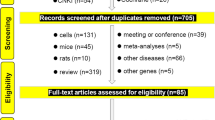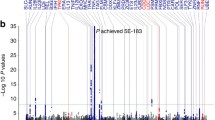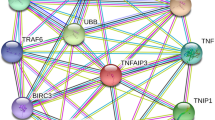Abstract
Increased CD143 activity has been detected in various skin tissues, and this increase is partially caused by the intronic ID polymorphism. The genetic contribution of CD143 ID polymorphism to the progression of psoriasis, the commonest skin disease, has been extensively investigated, but reported with inconsistent results. The aim of this work was to gain new insights to shed light on the association between CD143 ID polymorphism and psoriasis risk. We systematically identified the studies examining the association of CD143 ID polymorphism with psoriasis risk. A meta-analysis combining data from all eligible studies was carried out. To evaluate the genetic association, we calculated odds ratio (OR) and its 95 % confidence intervals (CIs) for both genotypic models and allelic model. The final pooling dataset comprised ten studies. Meta-analysis of total samples did not suggest a notable association with psoriasis risk. However, subgroup analysis by ethnicity revealed a statistically significant association in East Asian samples (DD + ID vs. II: OR 0.86, 95 % CI 0.75–0.99, Pheterogeneity = 0.970; DD vs. ID: OR 0.85, 95 % CI 0.73–0.99, Pheterogeneity = 0.868; D vs. I: OR 0.86, 95 % CI 0.76–0.97, Pheterogeneity = 0.994). This meta-analysis demonstrated that the presence of CD143 ID polymorphism may modify the risk of psoriasis in individuals with East Asian ancestry.



Similar content being viewed by others
References
Parisi, R., et al. (2013). Global epidemiology of psoriasis: A systematic review of incidence and prevalence. Journal of Investigative Dermatology, 133(2), 377–385.
Cai, Y., Fleming, C., & Yan, J. (2012). New insights of T cells in the pathogenesis of psoriasis. Cellular & Molecular Immunology, 9(4), 302–309.
Schon, M. P., & Boehncke, W. H. (2005). Psoriasis. New England Journal of Medicine, 352(18), 1899–1912.
Huerta, C., Rivero, E., & Rodriguez, L. A. (2007). Incidence and risk factors for psoriasis in the general population. Archives of Dermatology, 143(12), 1559–1565.
Nestle, F. O., Kaplan, D. H., & Barker, J. (2009). Psoriasis. New England Journal of Medicine, 361(5), 496–509.
Valdimarsson, H., et al. (2009). Psoriasis–as an autoimmune disease caused by molecular mimicry. Trends in Immunology, 30(10), 494–501.
Reich, K., et al. (2002). Promoter polymorphisms of the genes encoding tumor necrosis factor-alpha and interleukin-1beta are associated with different subtypes of psoriasis characterized by early and late disease onset. Journal of Investigative Dermatology, 118(1), 155–163.
Hensen, P., et al. (2003). Interleukin-10 promoter polymorphism IL10.G and familial early onset psoriasis. British Journal of Dermatology, 149(2), 381–385.
Koks, S., et al. (2005). Possible relations between the polymorphisms of the cytokines IL-19, IL-20 and IL-24 and plaque-type psoriasis. Genes and Immunity, 6(5), 407–415.
Campalani, E., et al. (2006). Apolipoprotein E gene polymorphisms are associated with psoriasis but do not determine disease response to acitretin. British Journal of Dermatology, 154(2), 345–352.
Plant, D., et al. (2006). The CX3CL1-CX3CR1 system and psoriasis. Experimental Dermatology, 15(11), 900–903.
Rice, G. I., et al. (2006). Circulating activities of angiotensin-converting enzyme, its homolog, angiotensin-converting enzyme 2, and neprilysin in a family study. Hypertension, 48(5), 914–920.
Petrov, V., Fagard, R., & Lijnen, P. (2000). Effect of protease inhibitors on angiotensin-converting enzyme activity in human T-lymphocytes. American Journal of Hypertension, 13(5 Pt 1), 535–539.
Zagato, L., et al. (2005). Direct assessment of angiotensin-converting enzyme activity on the surface of human skin fibroblasts in culture. Analytical Biochemistry, 338(2), 344–346.
Huskic, J., & Alendar, F. (2007). Tissue angiotensin-converting enzyme in patients with various clinical forms of psoriasis. Bosnian Journal of Basic Medical Sciences, 7(2), 103–106.
Huskic, J., et al. (2008). Serum and tissue angiotensin converting enzyme in patients with psoriasis. Collegium Antropologicum, 32(4), 1215–1219.
Rigat, B., et al. (1990). An insertion/deletion polymorphism in the angiotensin I-converting enzyme gene accounting for half the variance of serum enzyme levels. Journal of Clinical Investigation, 86(4), 1343–1346.
Ozkur, M., et al. (2004). Association of insertion/deletion polymorphism of the angiotensin-converting enzyme gene with psoriasis. British Journal of Dermatology, 151(4), 792–795.
Chang, Y. C., et al. (2007). Association between the insertion/deletion polymorphism of the angiotensin I-converting enzyme gene and risk for psoriasis in a Chinese population in Taiwan. British Journal of Dermatology, 156(4), 642–645.
Liu XH, Z.S., Zhao ZQ, Zhao D, Song LY, Yang H (2007) Study on the relationship between insertion/deletion polymorphism of angiotensin-converting enzyme gene with psoriasis. Chinese Journal of Dermatology Venere. 21, 199–200.
Higgins, J. P., et al. (2003). Measuring inconsistency in meta-analyses. BMJ, 327(7414), 557–560.
Mantel, N., & Haenszel, W. (1959). Statistical aspects of the analysis of data from retrospective studies of disease. Journal of the National Cancer Institute, 22(4), 719–748.
DerSimonian, R., & Laird, N. (1986). Meta-analysis in clinical trials. Controlled Clinical Trials, 7(3), 177–188.
A, T., Assessing the influence of a single study in the meta-analysis estimate 8. Stata Tech Bull, 1999: p. 15–17.
Egger, M., et al. (1997). Bias in meta-analysis detected by a simple, graphical test. BMJ, 315(7109), 629–634.
Weger, W., et al. (2007). The angiotensin-converting enzyme insertion/deletion and the endothelin -134 3A/4A gene polymorphisms in patients with chronic plaque psoriasis. Experimental Dermatology, 16(12), 993–998.
Nagui, N. A., Hay, M. R. A., & Rashed, L. (2012). Association between the angiotensin-converting enzyme gene insertion/deletion polymorphism and the risk for psoriasis. Journal of the Egyptian Women’s Dermatologic Society, 9, 14–17.
Al-Awadhi, A. M., et al. (2007). Angiotensin-converting enzyme gene polymorphism in patients with psoriatic arthritis. Rheumatology International, 27(12), 1119–1123.
Veletza, S., et al. (2008). Assessment of insertion/deletion polymorphism of the angiotensin converting enzyme gene in psoriasis. Journal of Dermatological Science, 49(1), 85–87.
Coto-Segura, P., et al. (2009). Lack of association between angiotensin I-converting enzyme insertion/deletion polymorphism and psoriasis or psoriatic arthritis in Spain. International Journal of Dermatology, 48(12), 1320–1323.
Yang, K., et al. (2014). Angiotensin-converting enzyme insertion/deletion polymorphism and susceptibility to psoriasis in a Chinese population. Journal of Renin-Angiotensin-Aldosterone System, 15(1), 39–43.
Vasku, V., Vašků, A., Holla, L., Kaokova, K., Znojil, V., Semradova, V., et al. (1999). Interaction of five gene polymorphisms at psoriasis. Journal of Investigative Dermatology, 113, 494.
Song, G.G., et al., The angiotensin-converting enzyme insertion/deletion polymorphism and susceptibility to rheumatoid arthritis, vitiligo and psoriasis: A meta-analysis. Journal of Renin-Angiotensin-Aldosterone System, 2013.
Murphey, L. J., et al. (2000). Angiotensin-converting enzyme insertion/deletion polymorphism modulates the human in vivo metabolism of bradykinin. Circulation, 102(8), 829–832.
Ryder, K. W., et al. (1985). Serum angiotensin converting enzyme activity in patients with psoriasis. Clinica Chimica Acta, 153(2), 143–146.
Author information
Authors and Affiliations
Corresponding authors
Additional information
Tianbao Xia and Jinfu Diao have contributed equally to this study.
Rights and permissions
About this article
Cite this article
Xia, T., Diao, J., Huang, H. et al. Evaluation of the Association Between CD143 Gene Polymorphism and Psoriasis. Cell Biochem Biophys 70, 1617–1623 (2014). https://doi.org/10.1007/s12013-014-0104-4
Published:
Issue Date:
DOI: https://doi.org/10.1007/s12013-014-0104-4




